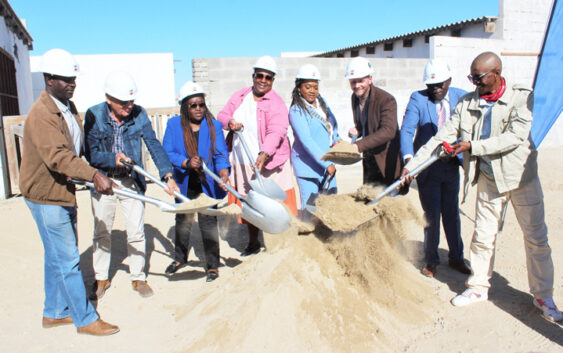- HOW TEMANE-MAPUTO ELECTRICITY TRANSMISSION LINE PROJECT IS GOING THROUGH TEST IN MOZAMBIQUE
- NEWLY OPENED PLASTIC RECYCLING PLANT SET TO HELP COMBAT NAMIBIA's PLASTIC INDUSTRY
- PROGRESS MADE ON PIIM PROJECTS AS OVER 85% COMPLETED IN ANGOLA
- WORLD BANK KICK-OFF INSPECTION OF USMID PROGRAM IN UGANDA
- ALGERIA MINISTER RECIEVED HARBOR ENERGY CEO OVER ENERGY PARTNERSHIP
LOW COST HOUSING PROJECT ON COURSE IN SWAKOPMUND, NAMIBIA

Eighty beneficiaries of the Build Together Programme at Swakopmund have elected to shoulder the responsibility of constructing their own houses.
This is after the beneficiaries requested that their loans be paid directly to them to enable them to hire their contractors.
This is a deviation from the norm of the project’s implementation, which is traditionally managed by the local council.
This action is a solution to the array of challenges reportedly plaguing the Swakopmund Municipality, namely budget overruns and cumbersome procurement procedures.
These details were shared by Swakopmund mayor Dina Namubes during the groundbreaking ceremony for the third phase of the Build Together Programme on Friday.
The programme, initiated by the Namibian government, offers affordable housing solutions to low-income Namibians. It is based on principles of self-help and community labour contribution and includes loans for the construction of houses.
The project has encountered several stumbling blocks, particularly regarding the allocation of 80 erven slated for the construction of houses.
“The quotations received from contractors far exceeded our budget, necessitating us to seek ministerial approval to exempt the programme and collaborate with the Shack Dwellers Federation of Namibia and the Namibian Institute of Mining and Technology (NIMT),” Namubes said.
However, these attempts were unsuccessful as both organisations either quoted figures beyond the budget or expressed their inability to participate due to the high material costs. As an alternative, the council allowed beneficiaries greater autonomy over their construction process.
Each beneficiary will receive an N$80 000 loan, distributed in four payments, to finance their home construction, following an agreement.
Namubes often reiterated “You agreed to this, yes?” during her address, emphasising that the beneficiaries had willingly assumed this responsibility.
Local building contractor Herberth Aibeb expressed his commitment to assisting beneficiaries of the programme without prioritising profits.
“Our focus isn’t to profit from this project, but to lend a hand to the affected community,” he said, estimating that the beneficiaries could move into their new homes in approximately four to five months.
Deputy mayor David Am-!Gabeb cautioned beneficiaries against reselling their newly constructed homes and emphasised that the houses represent more than mere physical structures, they are symbols of their struggle for a better life.
He underscored the fact that many residents often find themselves without a home again and living in an informal settlement after selling their government-allocated houses due to financial struggles or short-term gains.
“For those who choose to sell, there may not be a second chance to own a home again through this programme.”
Councillor Suamma Kautondokwa acknowledged that the groundbreaking event testified to the council’s commitment to delivering decent housing and basic amenities for the community.
“Structured cooperation can lead us to our goal – housing for all Swakopmunders,” she said.
Swakopmund Build Together committee chairperson Jeanette Fredericks acknowledged the long and often daunting journey many beneficiaries had undertaken since applying in 2005.
“We need to take care of our property and strive to complete construction on time, while also ensuring that we settle our bills promptly,” she said.
The Swakopmund Municipal Council recently allocated a substantial portion of its N$685 million budget to housing and land release projects, with N$6,7 million reserved for housing projects which will enable families to become first-time homeowners. A further N$15,5 million has been allocated for servicing land for future use, including provisions for waste management, electrification, water, and sanitation.
“We’ve allocated substantial funding for our priority programme of land release for thousands of new social housing units in well-located parts of the town,” chairperson of the council’s management committee Wilfried Groenewald said at the budget tabling.
According to him, more people are flocking to Swakopmund, drawn by better job opportunities, education, and healthcare options. This influx has put a strain on housing availability, prompting the council to take decisive action.
Swakopmund is currently home to approximately 14 000 ratepayers, with about 22 000 individuals seeking a house or property.
SOURCE: Namibian

